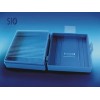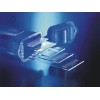      |

3-Dthin film coating 三维薄膜涂层
NEXTERION® Slide H
SCHOTT launched NEXTERION® Slide H as a dedicated slide surface for printing protein microarrays, as it is ideally suited for the covalent immobilization of peptides and proteins such as antibodies, antibody fragments, enzymes, or receptors. For many protein microarray applications NEXTERION® Slide H has proven to be a very attractive alternative to the commonly used nitrocellulose coated slide, especially where low background, or slide transparency are important considerations. Since its introduction, the slide coating has also been successfully used with amino-modified oligonucleotides, and has become the slide of choice for printing amino-linked glycan microarrays.
Carbohydrate arrays are a rapidly growing area of microarray research and NEXTERION®Slide H is an excellent choice for use in the rapid screening of carbohydrateprotein interactions. The permeable, polymer coating has a large immobilization capacity, and helps to preserve the native three-dimensional structure of complex bio-molecules, thus maintaining conformation and functionality.
NEXTERION® Slide H produces excellent signal-to-background ratios and an exceptionally wide dynamic range compared to conventional “two-dimensional” coatings through a unique combination of low non-specific binding characteristics, and high probe loading capacity. Even very low intensity signals, such as those obtained from low-abundance analytes, or weakly expressed genes can be reliably detected and quantified on NEXTERION® Slide H. The robust coating matrix is fully compatible with commercial microarray printers and scanners. Simple and robust protocols are available making NEXTERION® Slide H easy-to-use.
| Type of coating | Immobilization method | Typical probes | Ordering information | |||
| NEXTERION®product | Barcode option | Item number | Slides per pack | |||
| Thin film 3-D polymer surface |
Amine reactive chemistry Covalent binding |
• Proteins • Amino-linked glycans • Amino-linked oligonucleotides |
Slide H | Laser | 1070936 | 25 |
| Key product features |
| • Ideal substrate for printing protein, amino-modified glycans or oligonucleotide microarrays |
| • High probe loading capacity |
| • Exceptionally wide dynamic range |
| • Very low non-specific binding characteristics |
| • Optimal preservation of native structure and biological activity of protein probes |
| • Compatible with all common microarray printers and scanners |
| Typical applications |
| • Proteome expression profiling |
| • Functional protein arrays |
| • Transcriptional profiling |
| • Biomarker discovery |
| • Detection of protein modifications |
| • Carbohydrate–protein interactions |
| • Bacteria serotyping |
| • Immunoassays |
| Suitable probe types |
| • Antibodies and antibody fragments |
| • Functional proteins such as enzymes or receptors |
| • Small protein fragments such as peptides |
| • Amino-modified oligonucleotides 16 to 70 mers |
| • Amino-linked glycans |
| • Cells |
Immobilization chemistry


